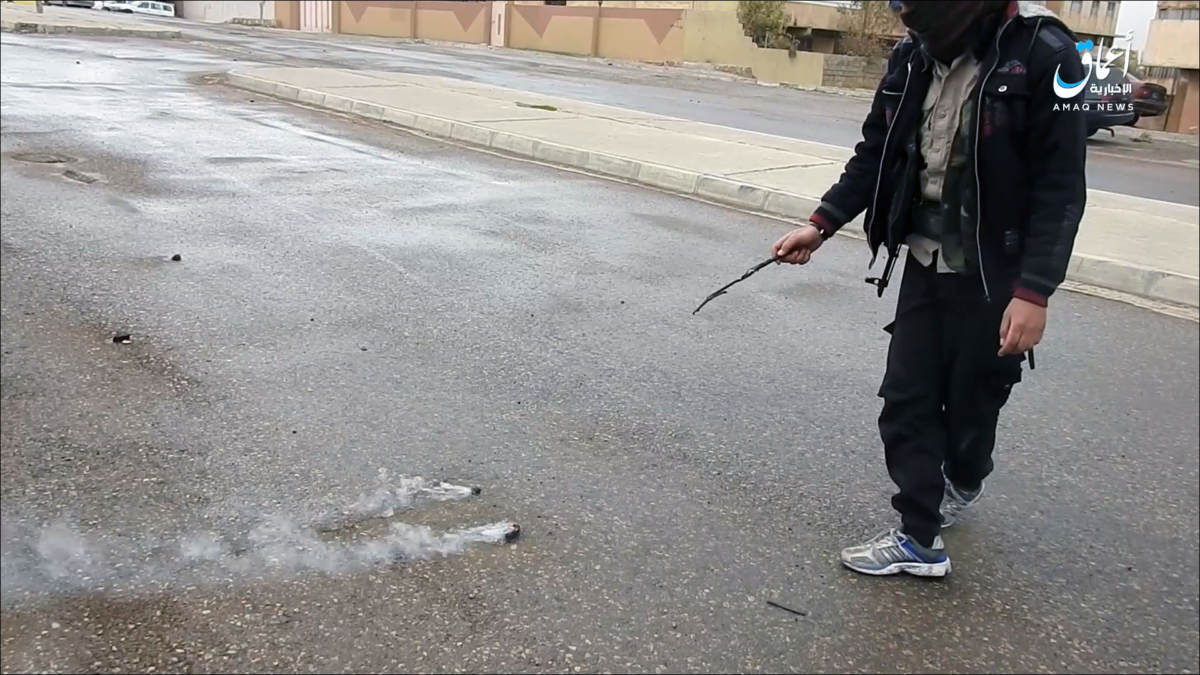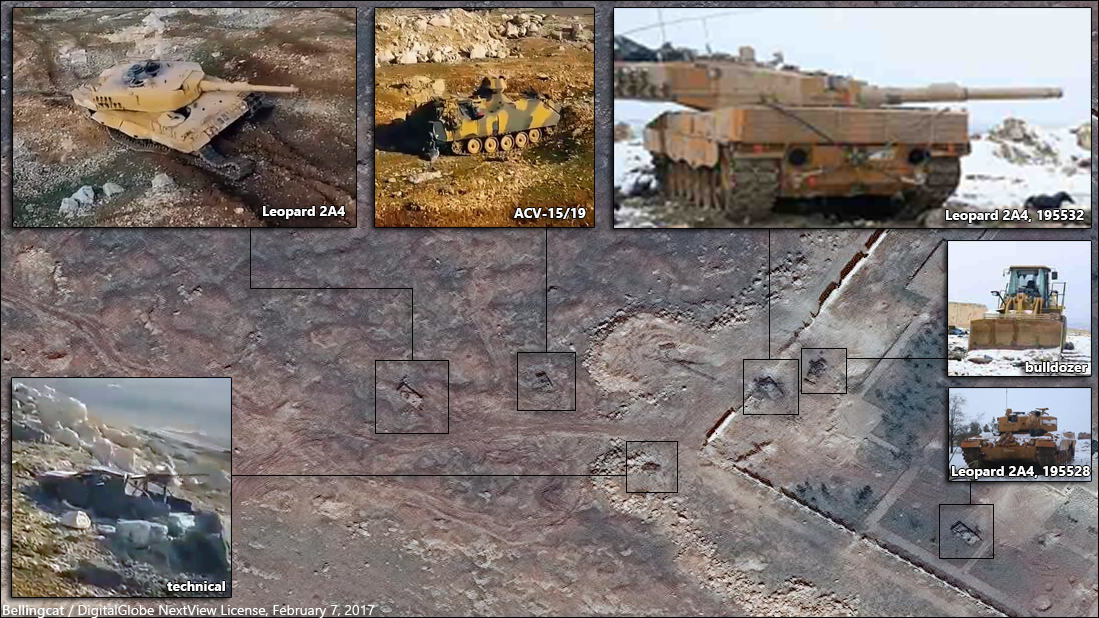Jaysh Usud al-Sharqiya: Exiles of the Euphrates
From eastern Aleppo to Raqqa to Mosul, the Islamic State (IS) appears to be losing ground on all sides in recent months. The same pattern holds true in southeastern Syria, a region that stretches from the Jordanian border to the city of Palmyra to the Euphrates river and only rarely features in reporting on the conflict. Since the beginning of 2017 local opposition groups have been advancing on IS territory along three fronts: the Eastern Qalamoun mountains southwest of Palmyra, the Bir Kessab pocket largely in the northeast of as-Suwayda governorate, and in al-Badiya (meaning ‘the desert’) along the Rif Dimashq-Homs border. One of the key rebel factions behind these advances is the Free Syrian Army (FSA) affiliated Jaysh Usud al-Sharqiya, or the ‘Army of the Eastern Lions’. Formed by fighters fleeing Deir ez-Zor after its fall to the IS, Usud al-Sharqiya is motivated by hopes of returning to their hometown where IS and the Syrian government both control territory.
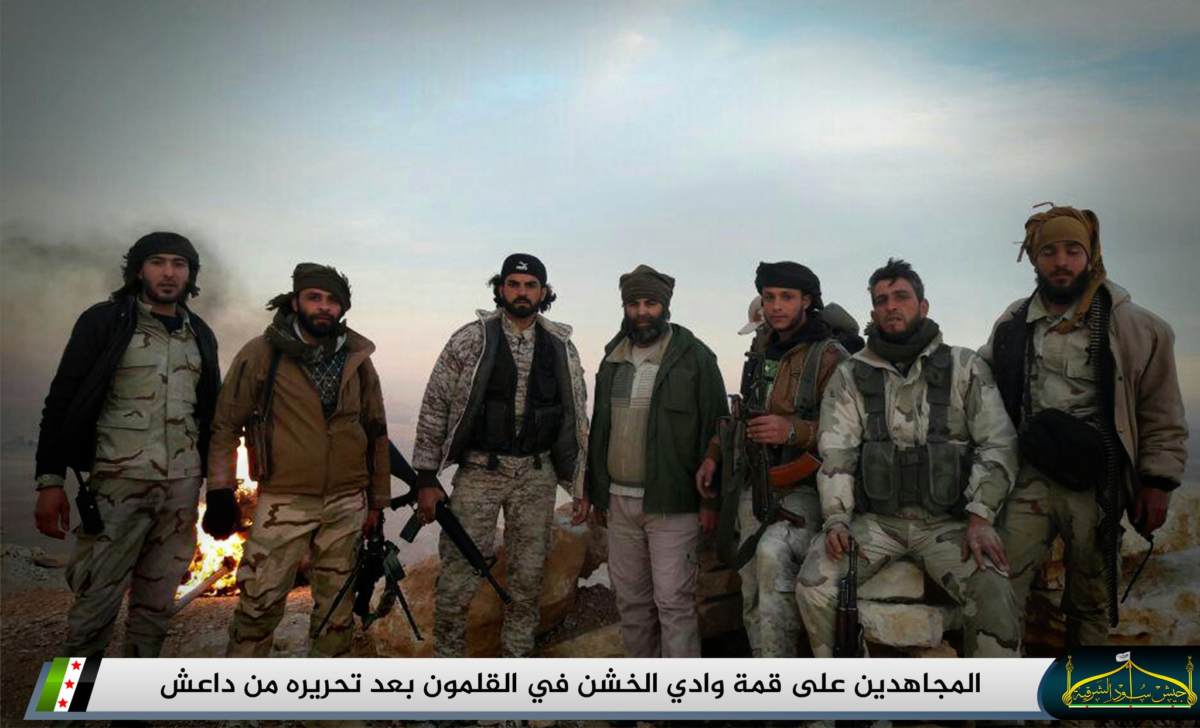
Jaysh Usud al-Sharqiya fighters in Eastern Qalamoun, March 2017.
The Road to Qalamoun
Jaysh Usud al-Sharqiya was formed in the wake of what was then called ‘the Islamic State in Iraq and al-Sham’s’ (ISIS) dramatic seizure of the Euphrates river valley in mid-2014. The Deir ez-Zor Governorate had been a bastion of the Syrian revolutionaries since 2011 and hosted a wide range of rebel factions, including local FSA groups and the nationwide al-Qaida-linked jihadist faction Jabhat al-Nusra. The opposition had taken control of most of the province and restricted government forces to Deir ez-Zor city and surrounding countryside by late 2013. This coincided with increasing ISIS presence in the area following their official expansion into Syria in April of 2013. War between ISIS and Syrian opposition groups eventually broke out the following January 2014. ISIS engaged in a tactical retreat in from Deir ez-Zor in February of that year only to launch a major offensive in the area in April. By mid-July, following its declaration of a caliphate and the changing of its name to ‘the Islamic State’, the jihadi organization controlled almost the entirety of Deir ez-Zor governorate. Local opposition fighters were driven westward after the city fell. While some, including the eastern Jabhat al-Nusra leadership, ended up in the Dara’a governorate, a multitude of groups that would come to make up Jaysh Usud al-Sharqiya sought refuge in a mountainous region northeast of Damascus called Eastern Qalamoun.
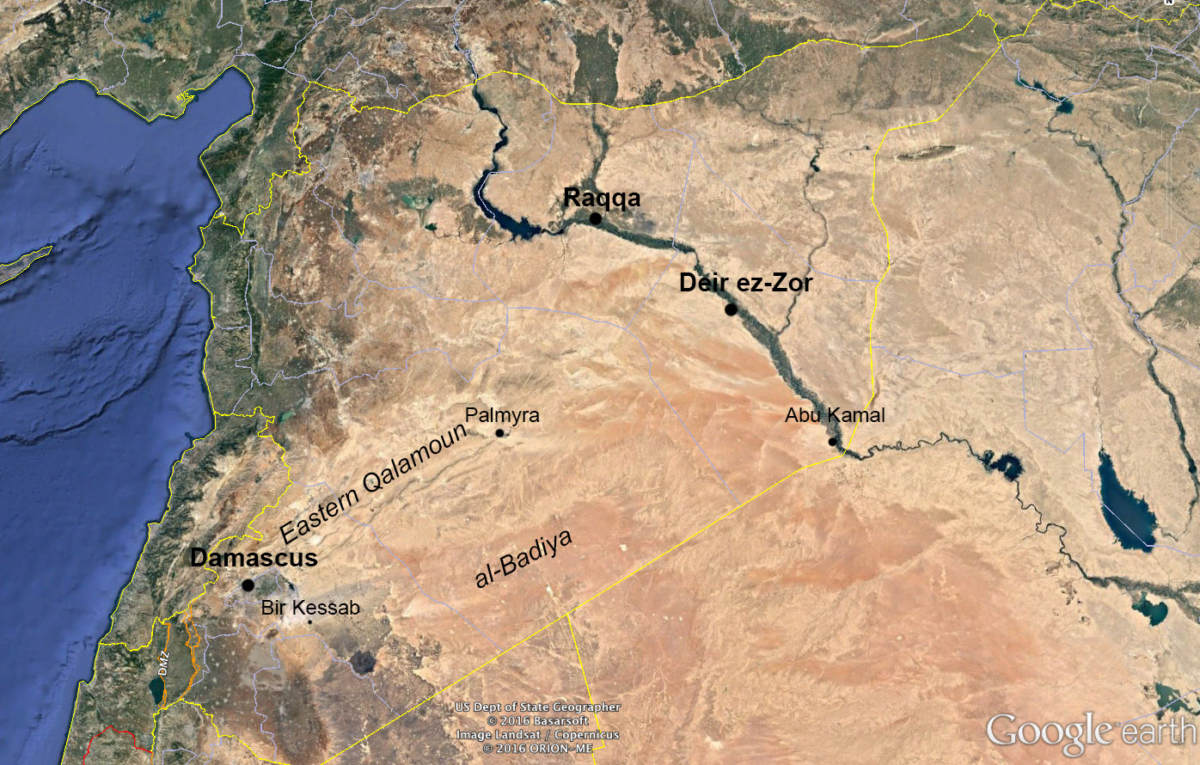
Key locations in southeastern Syria.
The Army’s Formation
Jaysh Usud al-Sharqiya declared its formation through the merger of twelve different ex-Deir ez-Zor factions on August 4, 2014 with a video released on YouTube (see below). Among these included the Eastern Front of the nationwide Jabhat al-Asala wa’l Tanmiya coalition (‘the Authenticity and Development Front’ or ADF), as well as Liwa al-Qadisiyah and Liwa Omar al-Mukhtar. The latter two factions featured prominently in the anti-ISIS fighting of that spring and were both mentioned in Aymenn Jawad al-Tamimi’s December 2013 article “The Factions of Abu Kamal”. Another noteworthy founding member was Bayariq al-Shaitat, a militia affiliated with the Deir ez-Zor-based al-Shaitat tribe. Al-Shaitat resistance against IS rule led to the massacre of reportedly seven hundred of its members in August 2014, one of the group’s most brutal crimes to date.
Abu Faisal Talas al-Salama of the ADF Eastern Front was chosen as Jaysh Usud al-Sharqiya’s General Commander and Abu Barzan al-Sultani was named their Deputy Military commander. Prior to the war, Al-Salama was the owner of a small factory in al-’Asharah, a town on the Euphrates between Deir ez-Zor city and Abu Kamal. Both Talas al-Salama and Al-Sultani are active on Twitter, as @abufaislosod and @barzanbarzan429 respectively (the group itself can be found @osoudalshrqia or @osodalshrqia_en, the new English language account). Talas al-Salama joined the rebellion in March 2012 and eventually came to lead Liwa Bashayir al-Nasr, one of the ADF Eastern Front component groups. He was also appointed as a member of the Deir ez-Zor Mujahideen Shura Council during the 2014 war with ISIS, demonstrating his importance within the local opposition.
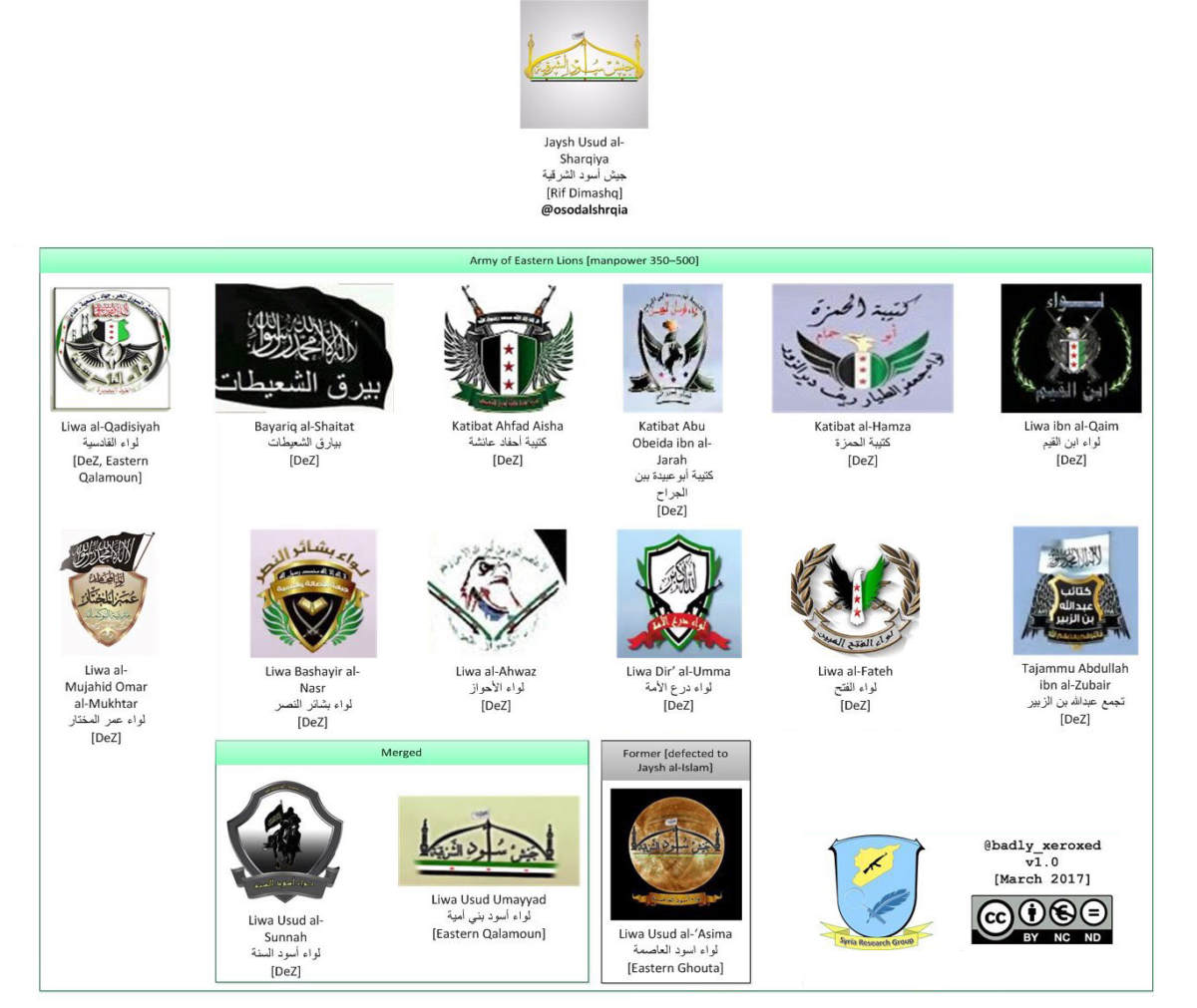
An Infographic by @badly_xeroxed portraying the factions that founded Jaysh Usud al-Sharqiya, as well as those that merged in later.
Talas al-Salama lays out the group’s raison d’etre in the August 4th video, stating that “given… the emergence of [the Islamic State] that has affected the course of the revolution, corrupted the Islamic project, labelled Muslims disbelievers… it is [Usud al-Sharqiya’s] revolutionary and lawful duty to confront and fight” the group. This is followed by a call on all who “care about Islam and the homeland” to join them in the fight against the “ungodly Safavid regime,” in reference to the al-Assad government and their ties to Iran. These statements both highlight the importance Jaysh Usud al-Sharqiya has always placed on fighting IS as well as the group’s Islamist orientation. Based on what information can be found regarding the ideology of Usud al-Sharqiya’s founding factions, it seems they belonged across the spectrum of the Syrian opposition. Several of these previous groups’ logos featured FSA symbols, including the green, white and red ‘revolution flag’ and depictions of eagles. Al-Tamimi concluded that neither Liwa Omar al-Mukhtar nor Liwa al-Qadisiyah appeared to have a political program outside of the ousting of Syrian President Bashar al-Assad in his aforementioned article.
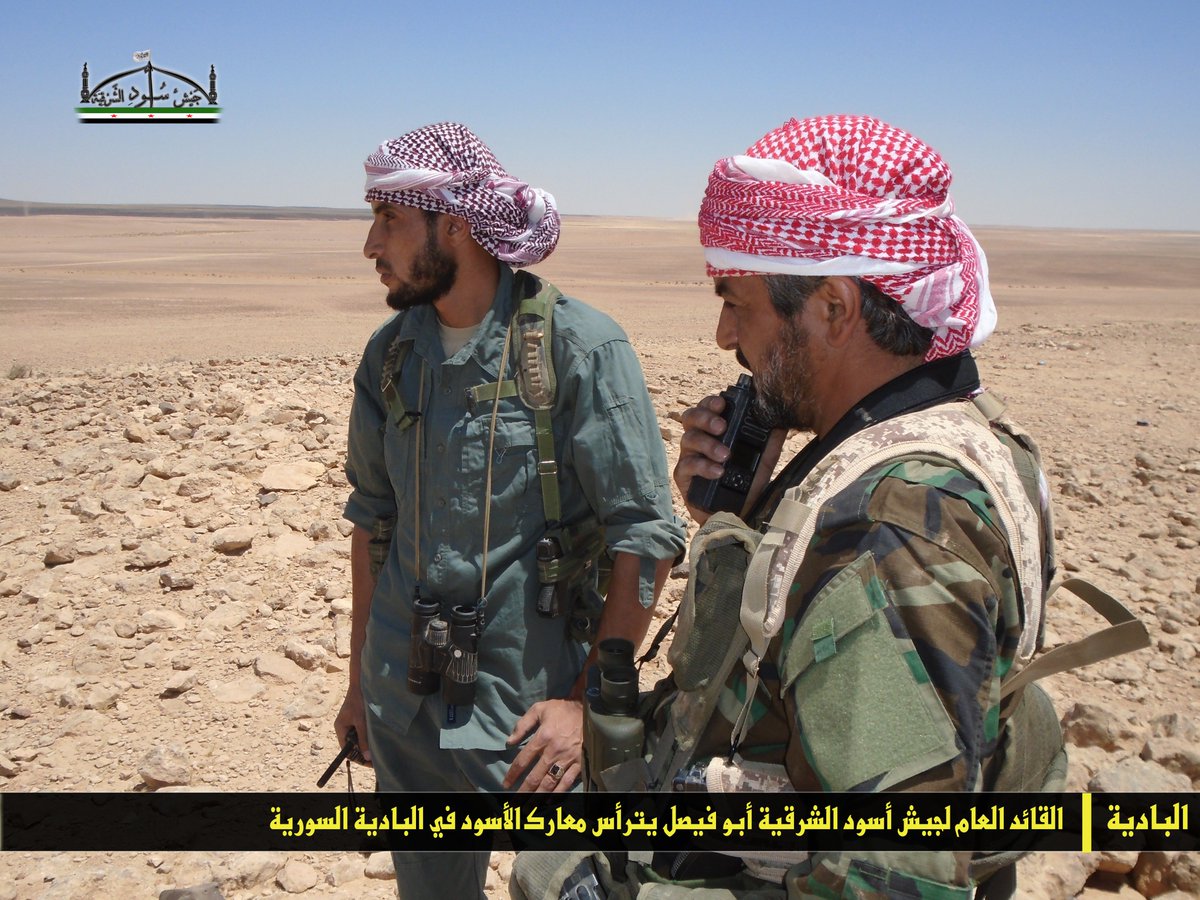
Abu Faisal Talas al-Salama (right) in al-Badiya, July 2016.
As discussed above, Jaysh Usud al-Sharqiya was founded as a local affiliate of Jabhat al-Asala wa’l Tanmiya who had long maintained a presence in Eastern Syria. The ADF is headed by “Secretary-General Khaled al-Hamad, a Salafi preacher based in the Gulf,” while the Front’s nationwide membership “is composed of a mixture of military defectors, civilian rebels, and Islamists”, according to analyst Aron Lund in Carnegie Middle East Centre. Sheikh Khaled al-Hamad labeled their ideology moderate Salafism in a February 2015 interview with Arabi21. Lund reported the group’s leadership as being “close to the so-called madkhaliya, which is a conservative but politically pliant [Saudi] Salafi tendency that supports the Saudi government.” This affiliation to a large national coalition enabled Usud al-Sharqiya access to the ADF’s regional support network. This fundraising web ties the ADF to several Gulf nations including Kuwait, according to Charles Lister’s book The Syrian Jihad. Being an ADF member group was crucial to Usud al-Sharqiya’s initial survival and eventual growth. According to their commander Talas al-Salama, the four hundred Deir ez-Zor exiles that would come to make up the army arrived in Eastern Qalamoun lacking in money and supplies and were often forced to sleep out in the open. As largely destitute and defeated outsiders it took a while for Usud al-Sharqiya to gain the trust and support of the local population. The army’s status as an ADF member group came to an end in December 2015 as they announced they were leaving the Front. Presumably this was partially due to Usud al-Sharqiya becoming self-sufficient and ingrained in the local opposition scene. Both Talas and Younes al-Salama have since expressed gratitude for Jabhat al-Asala wa’l Tanmiya’s support.
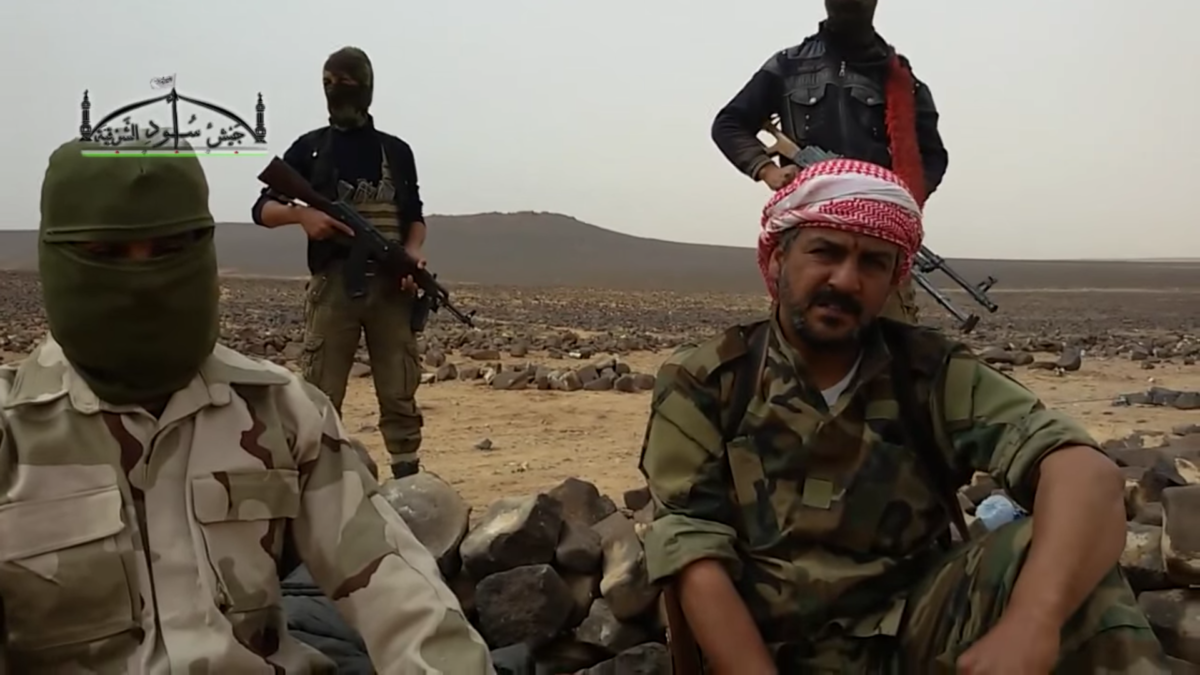
Abu Faisal Talas al-Salama (right, seated), April 2015.
The only place the faction has ever maintained a presence outside of Qalamoun and al-Badiya is within the opposition-held pocket known as Eastern Ghouta in the Damascus suburbs. The formation of Liwa Usud al-’Asima, an affiliate of Usud al-Sharqiya, was declared in a video uploaded to YouTube on January 17, 2015. The brigade was active in the Tishreen district of Qaboun neighborhood in northeastern Damascus. They were involved in coordinated rebel efforts to remove a local IS affiliated group from the neighbourhood. However, Usud al-’Asima merged into Jaysh al-Islam’s 8th Brigade only six months later due to local unification efforts in Qaboun.
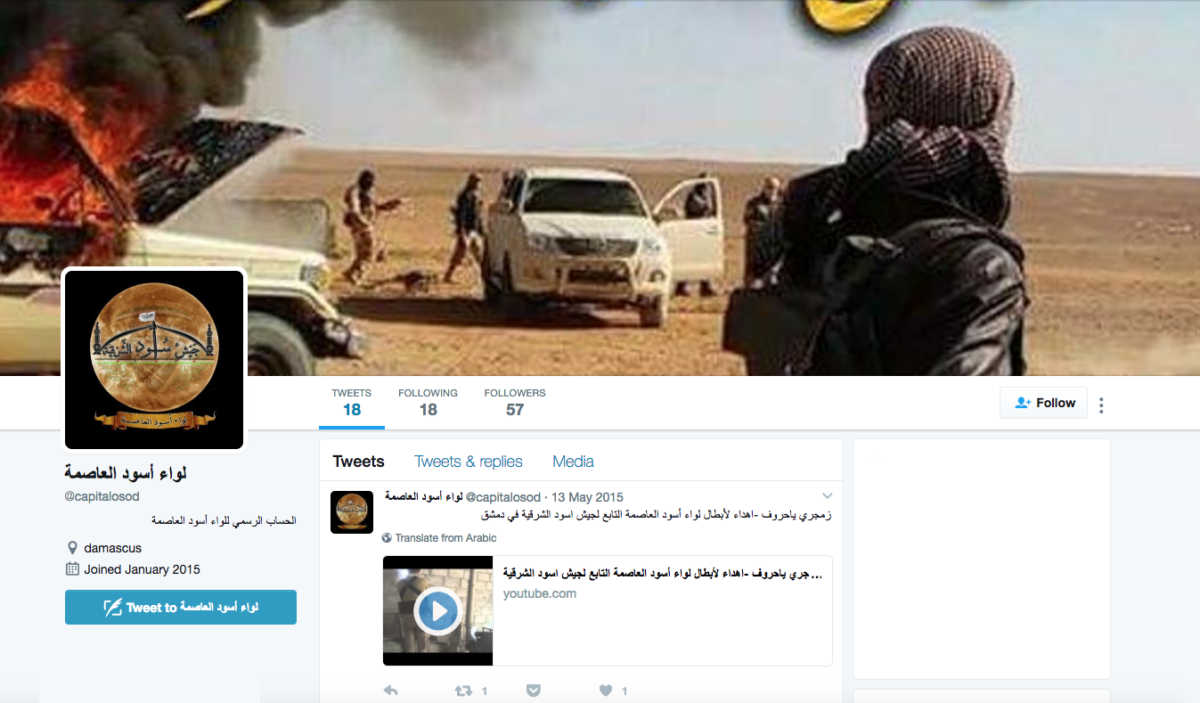
Liwa Usud al-‘Asima’s defunct Twitter page.
Size and Structure
Jaysh Usud al-Sharqiya was made up of three hundred and fifty fighters by January 2016, according to Talas al-Salama. Two hundred of these were from the original Deir ez-Zor contingent, while the rest were Qalamoun locals who had joined after the group’s formation. The following month two smaller Qalamoun factions would announce their merging into the army: Liwa Usud Umayyad and Liwa Usud al-Sunnah. Liwa Usud al-Sunnah appears to have been another old Deir ez-Zor faction from the town of Mayadin that was active alongside Liwa Bashayir al-Nasr in the ADF Eastern Front. According to press officer Younes al-Salama, Usud al-Sharqiya has had success recruiting other Deir ez-Zor exiles living in opposition-held Idlib and in Turkey who must cross the Jordanian border in order to join the army. This enlistment path has been disrupted as Jordanian authorities closed the border following an IS attack on the Rukban internally displaced people (IDP) camp in January of 2017. The groups that have been folded into Usud al-Sharqiya since its inception have not maintained individual identities. The only active subdivisions within the army are based on current geography: one sector for Eastern Qalamoun and one for al-Badiya. It’s not clear which of the two is bigger but since the beginning of the year the army has published significantly more media from al-Badiya. Younes al-Salama refused to disclose a more recent figure of the army’s total size when asked in March 2017, but between four and five hundred fighters seems like a reasonable estimation.
Military Equipment
On the battlefield Jaysh Usud al-Sharqiya makes extensive use of technicals, perfect for the mobile desert warfare that takes place along their frontlines. These vehicles are almost entirely Toyota Land Cruisers and Hiluxes outfitted with heavy machine guns, anti-aircraft guns, recoilless rifles, Multiple Launch Rocket Systems (MLRSs), and occasionally mounted Anti-Tank Guided Missiles (ATGMs). Overall, research on the group’s military equipment is complicated by their tendency to publish videos in conjunction with local ally Quwwat al-Shaheed Ahmed al-Abdo (‘Forces of the Martyr Ahmed al-Abdo’). Such videos often show conveys of ten to fifteen pickup trucks without faction logos on them, making it impossible to discern which belongs to whom. The most common artillery piece in the group’s arsenal appears to be the Soviet-made 57mm AZP S-60 transportable anti-aircraft gun, frequently used in a surface-to-surface capacity. As far as small arms go, Usud al-Sharqiya fighters are typically seen with AK and PK variants, Soviet-made standard issue equipment for the Syrian Arab Army. Usud al-Sharqiya is in possession of multiple T-55 tanks and at least one T-62 tank, captured from either IS or forces loyal to the Syrian government. In 2016, T-55s appeared in combat in at least three of Usud al-Sharqiya’s videos: once in January and twice in September. The T-62 has only ever been shown in combat in an image released on the group’s Twitter on March 16, 2017. Possibly the same T-62 briefly showed up in a September 2016 video. Both these T-62 appearances took place in Eastern Qalamoun.
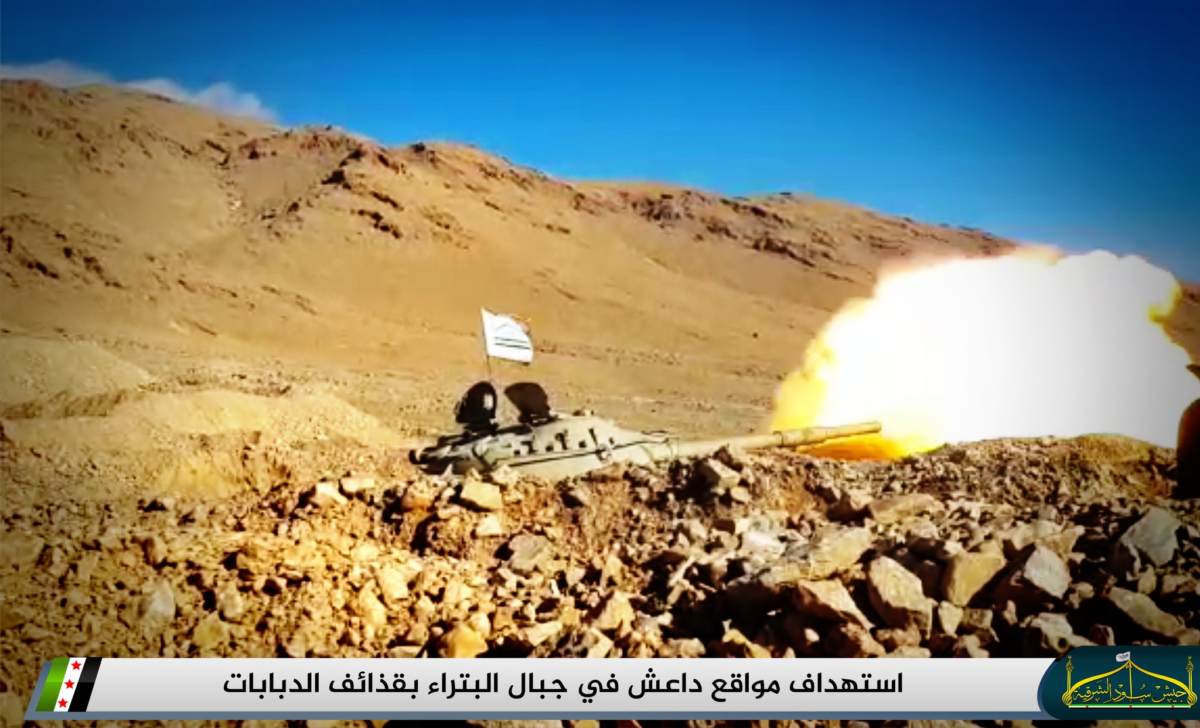
A Usud al-Sharqiya T-62 fires at IS positions in Eastern Qalamoun, March 2017.
There are several instances of ATGM usage by the army, dating back to January 2015. These include the use of the US-made BGM-71 tube-launched, optically tracked, wire-guided (TOW) missile, a weapon that is perhaps the most interesting part of the Syrian opposition’s arsenal. TOWs have been supplied to CIA-vetted rebel groups across the country since 2013 through Jordan- and Turkey-based Military Operations Command posts, commonly known as the MOC and the MOM respectively. It appears that several of Usud al-Sharqiya’s TOWs were captured from IS who had seized some from local CIA-vetted opposition groups, as well as the Iraqi Army. Since then, according to Younes al-Salama, the army has received some of such anti-tank missiles from the MOC. This foreign support dates back to at least the beginning of 2016 and continues to this day, according to the press officer.
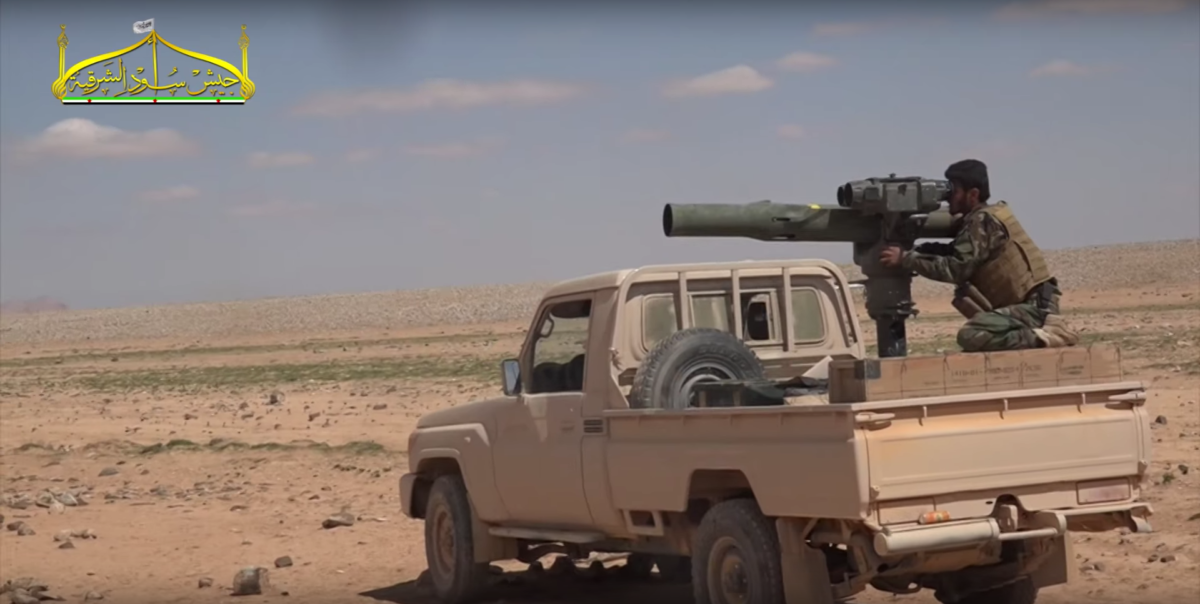
A member of Usud al-Sharqiya fires a TOW mounted to the back of a Toyota Landcruiser, March 2017.
MLSRs began appearing in the army’s videos since October 2016, specifically the RAK-12 128mm and the BM-21 Grad 122mm. At least two launchers of each of the two models are displayed but only one of the BM-21’s is marked with the Jaysh Usud al-Sharqiya logo, implying the other rocket launchers possibly belong to Ahmed al-Abdo forces. One of the Grad trucks, first appearing in a video released on February 6, 2017, appears to be quite new and is shown with thirty rockets loaded. Younes al-Salama has subsequently confirmed in a digital interview with the author that the truck and rockets had recently supplied to Usud al-Sharqiya by the MOC. Hiluxes outfitted with American-made M2 .50 caliber heavy machine gun have also started appearing in the group’s media, presumably from the MOC as well.
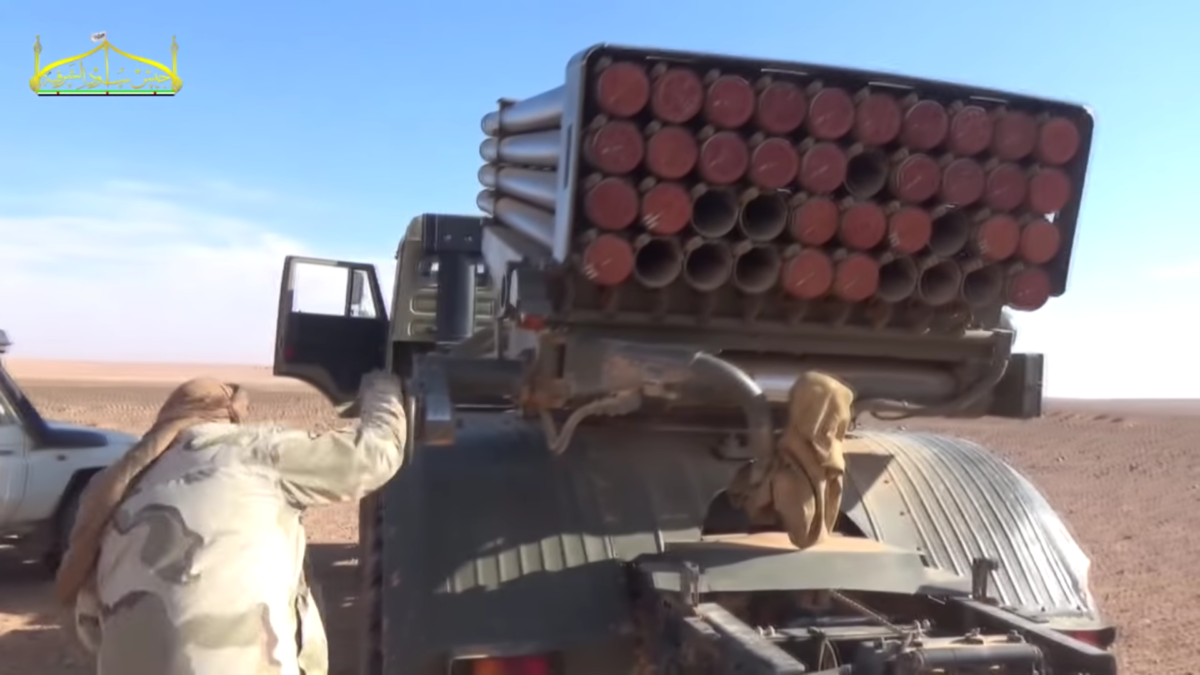
Usud al-Sharqiya display an almost fully loaded BM-21 Grad, February 2017.
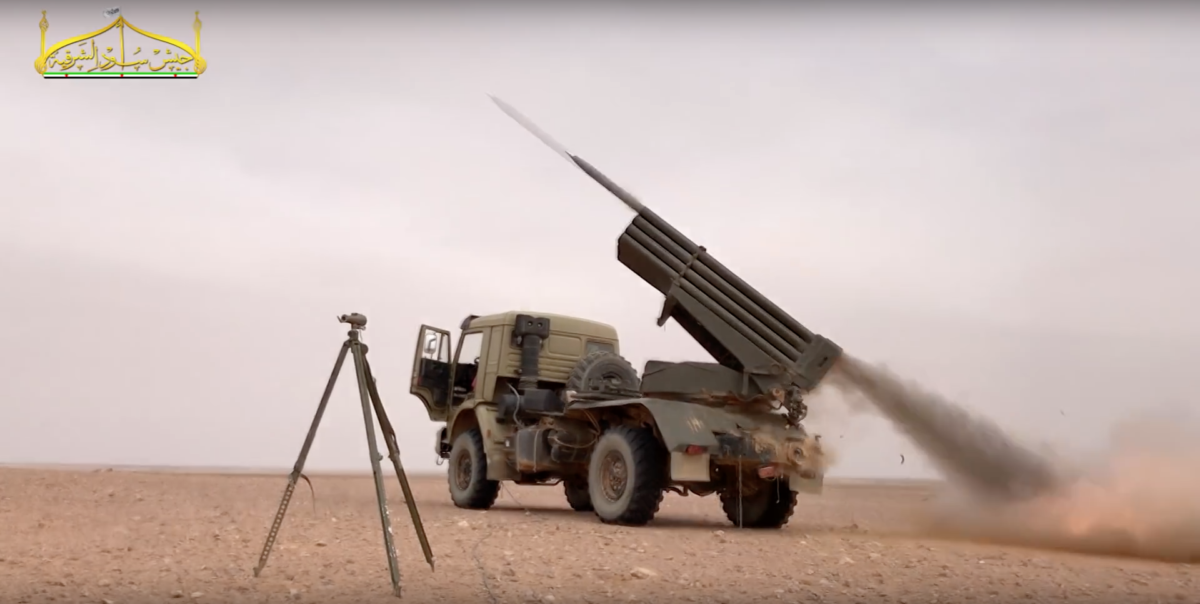
The Grad rocket truck recently supplied to Usud al-Sharqiya by the MOC, March 2017.
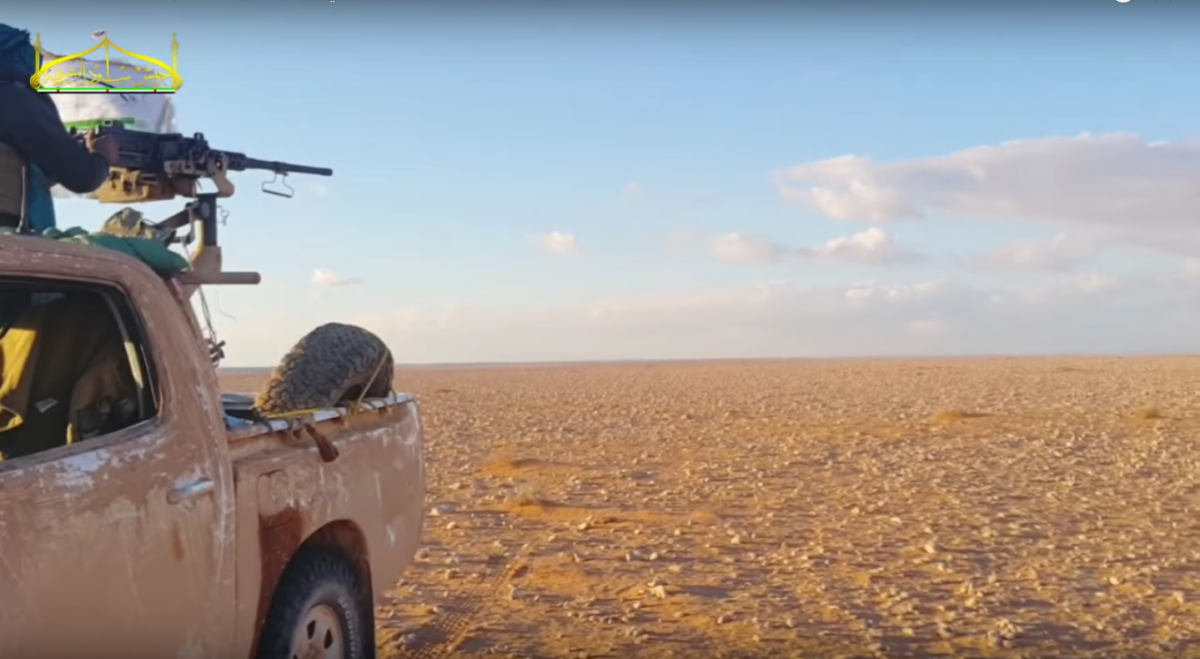
An American-made M2 .50 caliber machine gun mounted on a Toyota Hilux, February 2017.
The Battle of Sarajna al-Jiyad
This uptick in MOC support corresponds with recent developments in al-Badiya and Eastern Qalamoun. Over the past three months, Jaysh Usud al-Sharqiya has taken part in large-scale rebel operations targeting IS, alongside the Ahmed al-Abdo Forces and other local FSA factions. The fact that this offensive and operations room, currently known as “Sarajna al-Jiyad”, is targeting IS and not the government is presumably why foreign aid appears to have increased. In other parts of southern Syria, the Jordanian MOC has attempted to prevent rebel escalation against the government through the decreasing and cutting off material support.
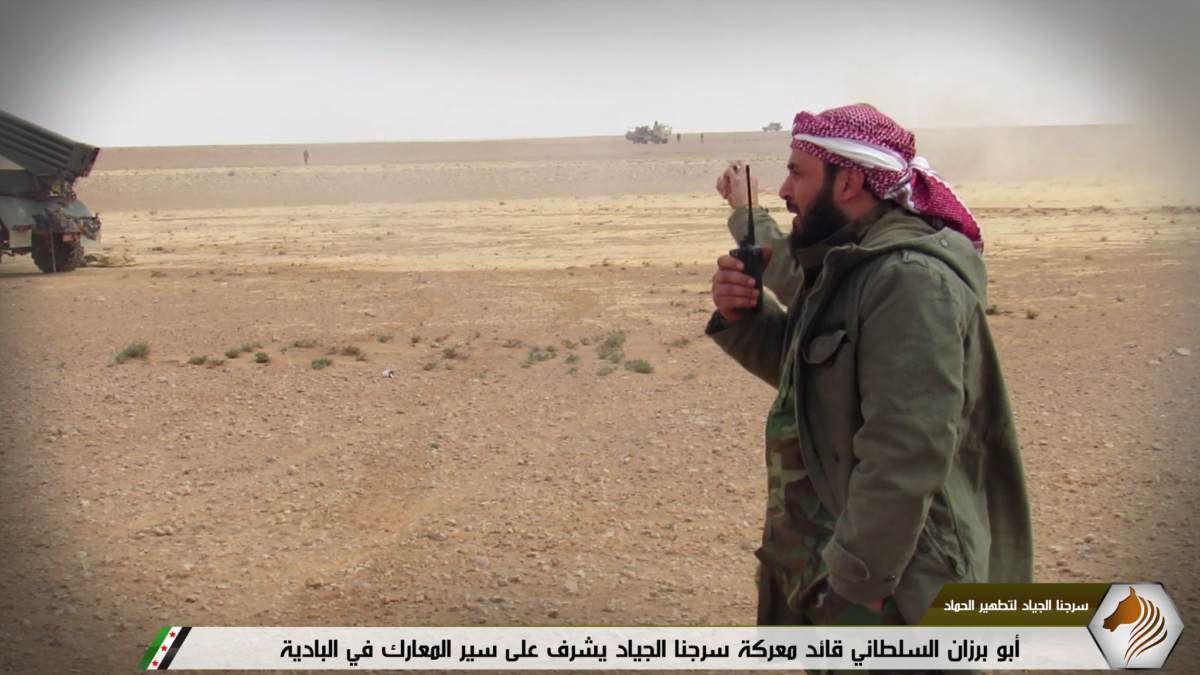
Abu Barzan al-Sultani during the Sarajna al-Jiyad battle (the logo can be seen at the bottom right), March 2017.
The objectives of this battle have been to liberate the IS’s Bir Kessab pocket along the as-Suwayda-Rif Dimashq border and to connect rebel territory in Eastern Qalamoun and al-Badiya. The first of these goals was accomplished by March 29, 2017, according to a map released by Usud al-Sharqiya. The town of Bir Kessab itself was taken two days prior in coordination with Jaysh Ahrar al-Asha’er, another FSA group participating in the Sarajna al-Jiyad battle. While hostilities with nearby loyalist forces have not broken out, both Jaysh Usud al-Sharqiya and the Ahmed al-Abdo Forces recently reported being targeted in government airstrikes and artillery bombardment multiple times since March 27. This however is likely a continuation of past government and Russian behavior, not a sign of upcoming escalation. Several al-Badiya factions have had their bases randomly targeted by Syrian or Russian planes in the past, including Usud al-Sharqiya in July 2016.
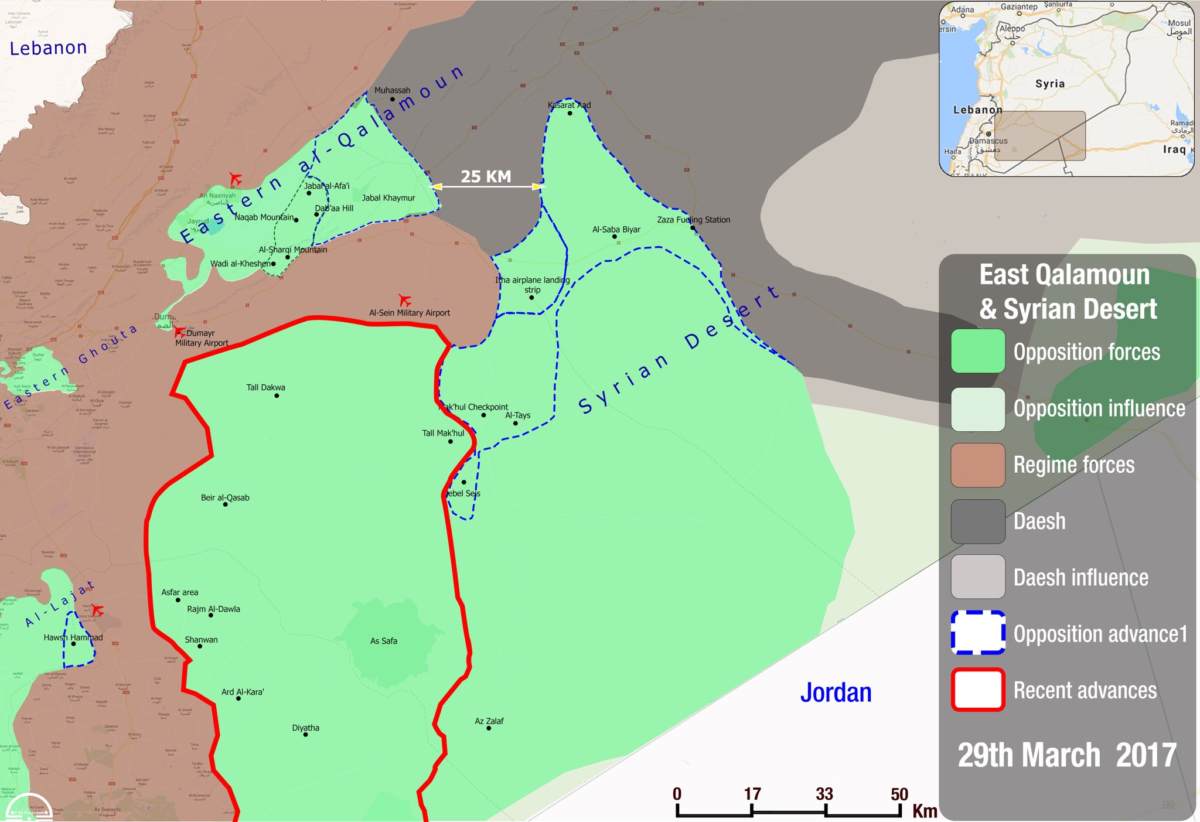
A map from @FSAplatform portraying recent opposition advances in al-Badiya and Eastern Qalamoun.
It appears likely that the Sarajna al-Jiyad factions will soon succeed in connecting Eastern Qalamoun to their territory in al-Badiya. As of March 29th it was reported that only ten kilometers of IS territory remained between the two pockets. In total, over three hundred kilometers of territory have been taken, though much of this is uninhabitable desert.
On March 30, Talas al-Salama told Arabi21 that many IS fighters have withdrawn east, most likely redeployed to Raqqa and Deir ez-Zor. While this means factions like Jaysh Usud al-Sharqiya should be able to quickly advance in the direction of the Euphrates, the porous nature of the desert frontlines mean IS infiltration and suicide vehicle attacks will remain a risk. Just recently, on April 9, IS launched a SVBIED-led attack on al-Tanf near the Syrian-Iraqi-Jordanian border, a location which Coalition forces use to train several local groups. Jaysh Usud al-Sharqiya sent a convoy of “six or seven vehicles” as reinforcements and lost two fighters in the process of defeating the surprise attack. The group released a statement on their new English language Twitter account regarding the al-Tanf on the same day. More such attacks should be expected as opposition groups continue to push IS east. Talas al-Salama has recently reiterated that Jaysh Usud al-Sharqiya is fighting to expulse the IS from the Syrian desert and eventually Deir ez-Zor. However in clearing the desert of IS opposition-loyalist frontlines will drastically increase. It remains to be seen if Usud al-Sharqiya and its allies will be able to maintain their focus on fighting the IS with the backing of the MOC, or whether these new frontlines with the Syrian government in eastern Homs will flair up.
